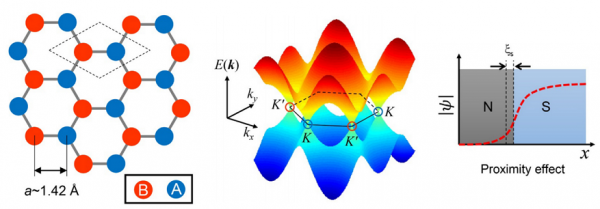[이길호, 이후종 교수 연구실] 초전도-그래핀 이종접합에서의 근접결합현상에 대한 리뷰, Proximity coupling in…
- No attach File
관련링크
main text

[그림: (왼쪽) 그래핀의 원자구조, (가운데) 그래핀의 전자구조, (오른쪽) 초전도 근접효과를 표현한 모식도, 빨간색 점선은 초전도 파동함수의 크기를 나타낸다.]
초전도-그래핀 이종접합에서의 근접결합현상에 대한 리뷰
포스텍 이길호 교수와 이후종 교수는 초전도-그래핀 이종접합에서의 근접결합현상에 대해 지 10여년간 세계적으로 영향력 있는 연구를 해온 것이 인정되어 Reports on Progress in Physics지에 초청리뷰를 게재하였다.
탄소원자 한층으로 이루어진 세상에서 가장 얇은 물질인 그래핀은 2004년도 처음 발견된 이래로 활발히 연구되고 있는 신소재이다. 그래핀은 탄소원자가 벌집구조로 결합하고 있는 물질로, 이 물질에 흐르는 전자는 마치 질량이 없는 상대론적 양자입자처럼 행동하는 특이한 특성을 가진다. 따라서 대형가속기를 이용하지 않더라도 상대론적 양자입자에 대한 기초연구를 할 수 있다는 점이 특히 흥미롭다. 한편, 100여년전 처음 발견된 초전도체는 일정 온도 이하에서 전기저항이 갑자기 없어지는 또다른 흥미로운 물질이다. 이는 거시적 스케일에서 나타나는 매우 희귀한 양자현상으로써, 특히 최근 양자정보분야의 급부상으로 큰 관심을 받고 있다.
이렇게 연관성이 없을 것 같은 그래핀과 초전도체를 서로 접합하면, 초전도가 아닌 그래핀의 일부가 초전도체의 성질을 띄게 되는 초전도 근접효과가 발생한다. 그래핀의 우수한 전기전도도, 용이한 전기적 조절성 등의 장점과 거시적 양자현상인 초전도현상의 특성이 섞이게 되면, 기존엔 전혀 볼 수 없었던 새로운 물리현상을 연구할 수 있고, 더 나아가 유용한 양자소자를 제작할 수 있다. 연구를 주도한 이길호 교수는 “이번 리뷰논문은 그래핀-초전도 양자소자분야의 지난 10여년간의 역사를 정리함으로써 관련분야에 중요한 이정표가 될 것으로 기대된다”고 밝혔다.
This review discusses the electronic properties and the prospective research directions of superconductor-graphene heterostructures. The basic electronic properties of graphene are introduced to highlight the unique possibility of combining two seemingly unrelated physics, superconductivity and relativity. We then focus on graphene-based Josephson junctions, one of the most versatile superconducting quantum devices. The various theoretical methods that have been developed to describe graphene Josephson junctions are examined, together with their advantages and limitations, followed by a discussion on the advances in device fabrication and the relevant length scales. The phase-sensitive properties and phase-particle dynamics of graphene Josephson junctions are examined to provide an understanding of the underlying mechanisms of Josephson coupling via graphene. Thereafter, microscopic transport of correlated quasiparticles produced by Andreev reflections at superconducting interfaces and their phase-coherent behaviors are discussed. Quantum phase transitions studied with graphene as an electrostatically tunable 2D platform are reviewed. The interplay between proximity-induced superconductivity and the quantum-Hall phase is discussed as a possible route to study topological superconductivity and non-Abelian physics. Finally, a brief summary on the prospective future research directions is given.


-2.gif)









 Login
Login


